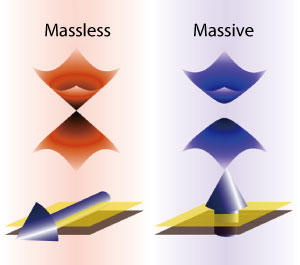

03/28/2016

Adapted with permission from Ref. 1. Copyrighted by the American Physical Society.
AIMR researchers have struck upon a convenient way to convert ultrafast electrons known as ‘massless Dirac fermions’ into ones that possess mass1. This has promise for realizing new devices such as magnetic-field sensors and magnetic memory devices.
Electrons moving through ultrathin layers on top of blocks of novel materials such as topological insulators have generated a lot of interest among materials scientists recently. Such electrons behave as essentially massless particles and move at speeds approaching that of light. Researchers strongly desire a way to manipulate Dirac fermions so that they can be easily changed between their massive and massless states.
Seigo Souma and co-workers at the AIMR, Tohoku University, have found a simple and effective way to convert massless Dirac fermions into massive ones: evaporate an atomically thin layer of iron atoms onto a small block of tungsten metal.
Unlike normal massive conduction electrons in metals, massless electrons lack a gap in their band structure. The ferromagnetism of the iron atoms opens a gap in the electrons’ band structure, making the electrons massive. “This is the first spectroscopic observation of a gap opened by a magnetic effect for a system in which ferromagnetism has been confirmed,” says Souma.
The researchers found that the electrons could be switched between massless and massive states by varying the direction of the spins of the iron atoms ― the electrons are massless when the spins lie in the plane of the layer, but become massive when the spins are perpendicular to the layer (see image). The direction of the electron spins can be controlled by tuning the thickness of the iron film or adsorbing oxygen onto the film.
Their method has two advantages over alternative schemes. First, the iron layer exhibits strong ferromagnetism that should persist well above room temperature (roughly 300 kelvin). This is in contrast to systems doped with magnetic ions where ferromagnetism disappears above about 30 kelvin.
The second advantage is that the gap size is considerably larger than previous systems, being over twice that achieved in topological insulators doped with magnetic ions. Since this gap size is approaching the thermal energy at room temperature, it holds the promise of realizing devices that operate at room temperature.
The team is excited about applying the concept to other systems, particularly topological insulators. “Our idea is rather simple and should be applicable to other systems,” notes Souma. “If we can find an appropriate overlay film that can be epitaxially grown on a topological insulator, various exotic phenomena will become experimentally accessible.”
Honma, K., Sato, T., Souma, S., Sugawara, K., Tanaka, Y. & Takahashi, T. Switching of Dirac-fermion mass at the interface of ultrathin ferromagnet and Rashba metal. Physical Review Letters 115, 266401 (2015). | article
This research highlight has been approved by the authors of the original article and all information and data contained within has been provided by said authors.